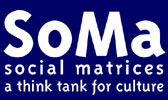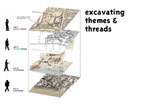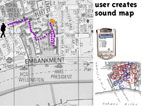
Urban
Tapestries
1AD
Appliance Design Conference, 6th May 2003
Giles Lane
Urban Tapestries is an interactive location-based wireless application allowing users to access and author location-specific multimedia content (such as local historical information, personal memories, pictures, short movies and sounds). It is a forum for sharing experience and knowledge, for leaving ephemeral traces of peoples’ presence in the geography of the city.
Urban Tapestries is more than a history trail, it is dynamically interactive rather than merely responsive. It enables a community’s collective memory to grow organically, allowing ordinary citizens to embed social knowledge in the new wireless landscape of the city. Users will be able to add new locations, location content and the ‘threads’ which link individual locations to local contexts.
Urban Tapestries privileges the experience of the user over typical ‘publishing’ systems (such as those found in museums) which control and author the user experience. For example, in addition to being able to upload text, sound and images to the system, at each Urban Tapestry location encountered, the user will be prompted to record an audio clip of their sound environment. These audio clips can later be edited together to create a ‘sound map’. Sound is indelibly linked to memory – often acting as a powerful trigger for recall. Each sound map will be a unique recording of a personal journey – something the users can later share with friends. Urban Tapestries affords its users a novel way of authoring their own experience of inhabiting the cityspace and communicating it to others via an album of memories structured around sound.
Urban Tapestries was conceived and initiated by Giles Lane, Alice Angus and Katrina Jungnickel who comprise Proboscis, a non-profit creative studio and think tank. The project began to take shape in July 2002 when the first visual scenario was developed. Interest in the project was shown by Phil Stenton at HP Labs and a dialogue initiated which led to the project being developed under HP Labs' City & Building Research Centre, as part of the DTI's Next Wave Technologies and Markets Programme. Other partners include the London School of Economics (social research), Orange (network partner) and the Financial Times (media sponsor). The project is co-funded by the Arts Council of England.
To develop the project Proboscis has assembled a multi-disciplinary team from among its associates: Danny Angus (system architecture), John Paul Bichard (interface design), Rachel Murphy (interaction concept design) and Nick West (information architecture). The project also employs a part-time research assistant, Zoe Sujon, at the London School of Economics supervised by Professor Roger Silverstone.
The project has its roots in previous work by Proboscis, such as the Private Reveries, Public Spaces project. PRPS looked at how private behaviours are affected by new and emerging technologies in public spaces. We commissioned 14 proposals from other artists and designers and developed 3 into 'conceptual prototypes' – playful but serious projects which could inspire and engage people beyond of the ghetto of digital art and design.
As we nurtured the overall framework for the project, as well as the 3 prototypes, we began to work on our own ideas of how network and communication technologies influence the ways we behave as private individuals in public spaces. The trajectory of this was to lead us to visualise what we thought would be a radical application of the technologies that hadn't seemed to occur to anyone else yet.
Urban Tapestries began as an experiment for our Sonic Geographies project, which aims to develop a series of new ways of experiencing the city based on sound. As research activity it straddles the two key themes of our research programme (SoMa: the social matrices think tank): Species of Spaces and Liquid Geography.
| System | |
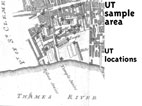 |
An Urban Tapestries system might be hosted by a school, local library or local chamber of commerce, perhaps to create an organic local archive of memory and history, or to embed local tourist information. Local residents and visitors would be able to add their own knowledge to the system, making it a dynamic public authoring platform. |
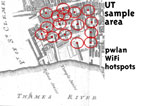 |
Many of the locations (tagged via GPS coordinates) would be covered by public wireless hotspots, such as those provided by WiFi nodes (802.11). |
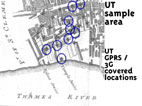 |
Others might rely on the user having a GPRS / UMTS service enabled on their mobile phone. The Urban Tapestries PDA application would use Bluetooth to communicate with the mobile phone to access content and locations not covered by WiFi hotspots. |
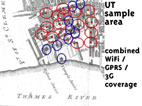 |
Combining both mobile and WiFi radio technologies will give Urban Tapestries flexibility both for accessing and publishing to the system, and in the range of devices that might be able to be used. |
| User Experience | |
|
Urban Tapestries seeks to create new ways of appreciating and interacting with the fabric of the city. It can both excavate and enrich the layers of experience that weave together in our everyday lives. |
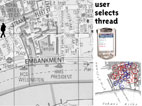 |
Users of Urban Tapestries will be able to select threads to follow (such as historical or social threads linking individual places), or drift across all the threads. Having selected a thread, the user will receive a map of the locations in the area associated with it. They can either follow it as a trail, or set the system to give a proximity alert when they pass a location. |
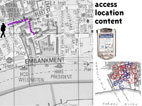 |
On arrival at a location, the user receives an alert. They can then access the content associated with the location. Content can be 'clipped' to the PDA and stored for later perusal. |
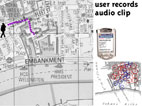 |
At each location the user is invited to record an audio clip of their sound environment. These form the basis of the sound maps which users can create as sonic albums or mappings of their journeys through the city. Each clip is linked to the location and its content. |
| Public Authoring | |
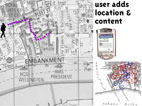 |
Public
Authoring is crucial to the unique vision of Urban Tapestries. Users will be able to add locations by tagging the GPS coordinates and uploading to the system. Content such as text, sounds, movies and images will also be uploadable, either from the PDA or via the internet. |
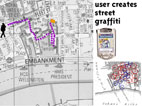 |
For more immediate social interactions, a time-limited street graffiti system will enable users to leave messages tagged to locations. Perhaps to announce a local event or just to leave an observation. |
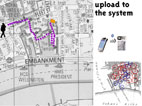 |
All these elements of public authoring will hinge on live uploading to the system. |
| Sharing | |
|
A key element of Urban Tapestries' interactivity is the sound maps that users can create from their recordings and associated location content. These maps will be saved in a format that will allow users to share them with others. |
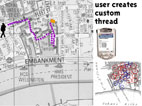 |
Users can create their own threads through an area: perhaps linking their favourite cafes, or sites of social or historical significance. These can be uploaded to the system for others to access as system threads. |
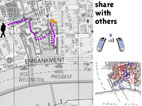 |
Sound maps, threads and content can be shared directly with other users via Bluetooth. |
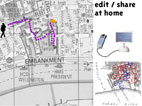 |
Or the sound maps can be uploaded to a desktop computer for editing and sharing via the internet. |
What distinguishes Urban Tapestries from the many eTourism projects being developed by hardware manufacturers, network providers and many universities, can be summarised in three categories:
1. Cooperative
Not Hierarchical
2. Co-creation Not Consumption
3. Accretive and Organic Not Static
Cooperative
Not Hierarchical
Urban Tapestries relies fundamentally on communities, not on service or
network providers. It is not meant to be a citywide ubiquitous applications,
but rooted in each community which hosts its own system. A local Urban
Tapestry could be a small as a street, or as big as a district.
Co-creation
Not Consumption
Urban Tapestries relies on the co-creation of its own content by its users,
rather than the consumption of pre-prepared content. The experience of
the last five years indicates that what drives adoption of technology
is not the pre-authored content served up by corporations and institutions,
but the abilities to communicate on a one to one and one to many level
that the internet and mobile phones offer.
Accretive
and Organic Not Static
An Urban Tapestry is aimed to grow with time, at the pace set by its users.
It is both the layering and excavation of layers of knowledge and experience
– a real-time microcosm of how our cities and communities develop,
prosper and die.
Possible hosts or maintainers of an Urban Tapestry might be a community group, school or local history archive, or perhaps a local trading association or chamber of commerce wishing to enhance the experience of visitors to their area.
Urban Tapestries also aims to be a platform for anonymous people-to-people communication. It is clear from both personal experience and recent research that a large percentage of mobile phone calls and text messages are based around gossip and observations rather than mission-critical commuication. An integral part of the system will be a time-limited ‘street graffiti’ system to enable people to leave messages for others that will fade with time. This aspect of the system will form a key part of designing patterns of use for new technologies, rather than simply products or services for consumption. Enabling users to define their own uses of the system rather than authoring their experiences is critical to the project’s aim of enhancing user-authored experiences rather than directing them.
[Concept Scenario Film: Experience]
Some key issues include:
Citizenship: Potential users of Urban Tapestries include both individual and community, local residents and visitors. The system’s ability to engage people with local geography has the potential to encourage greater knowledge of and sense of ownership of an area. This could have the effect of promoting a ‘cultural investment’ in the environment or a newcomer to the area may use the system to discover their new locale and to leave graffiti messages in order to meet and network with the community.
Public Authoring and Sharing Knowledge: As a user moves through the streets passively accessing the location based information, this inspires them to add their own locations, favourite threads and leave messages for others. Regular visitors or local residents using the system would be able to engage in extended anonymous interactions with others. This addition of individual memories is like an organic oral history, such as one might find in Local History and Heritage archives. Yet in this case it is informally developed – authored and shaped by its users, extending the archiving of local history beyond the library and encouraging greater everyday interaction.
Potential System Hosts: The system could be used by schools, colleges and community groups to encourage learning through investigation, exploration, interaction and play. Other hosts, such as museums might wish to adopt the system to allow visitors to share their observations and add to the ‘official’ knowledge. Local authorities, chambers of commerce, tourist boards might wish to adopt the system in an area to promote or enhance the experience of tourists.
Creating Experiences: A user whose family lives at a distance or overseas could use Urban Tapestries to create an audio map of the area in which they live or work to send to their family or to friends who are partially sighted or blind, much in the same way we create photo albums to create an experience of a place. Or a resident may wish to create a series of threads linking their favourite locations linked to a theme or idea (a literary exploration of Bloomsbury or the best coffee stalls at the market).
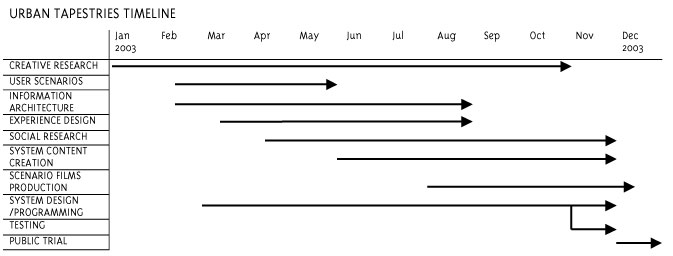
The Timeline above indicates the nested and inter-related phases of the project's development, as well as suggesting a sense of the collaborative effort of the different skills represented by the project's team members. Some of the key research issues we will be investigating on the project will be:
• Location Sensing: the prototype will use GPS as its primary location sensing technology, but we will also be investigating the practicality and benefits of other (perhaps complementary) technologies such as Cell Triangulation and the European Galileo positioning system.
• User Device: the prototype user device will be a PocketPC PDA with integrated Wi-Fi, Bluetooth and GPS. This device will provide all the access and publishing functionality that Urban Tapestries offers. However such devices are costly and exclude the possibility of different layers of access: therefore we will create client software that is compatible with different devices (such as more advanced mobile phones) that will allow their users to access some, if not all that Urban Tapestries offers. Instead of forcing users to adopt a specific technological solution, Urban Tapestries will allow its users to interact with it on their own terms: as consumers simply accessing content or as co-creators accessing and publishing to the system.
• Configuring the System: An Urban Tapestry will have both a host and users. We feel that it will have the most relevancy to its community of host and users if they can configure the system to their own needs. At the host level this could simply be limiting the size of files that users may publish to the system, or defining and limiting the kinds of threads that users can add. At the user level, it may be possible to design private threads that users can configure and manage themselves.
• Trust: the prototype system will assume a basic trust between host and users. However, it is possible to imagine scenarios whereby malicious use of the system could compromise both host and users. We will be exploring ways and means of embedding trust levels into the system, that protect both host and users from potential abuse.
1.
The Creative Lab
The Lab held on the 1st and 2nd May acted as a forum in which some of
the key issues that Urban Tapestries seeks to address were brought into
a wider public arena. The event brought together around 70 people from
many disciplines and practices – from artists and academics to technologists
and civil servants – into an environment designed for peer exchange
of knowledge. It explored the key issues of social knowledge and public
authoring from many different perspectives and created a platform for
the underlying ethos of Urban Tapestries to begin to circulate amongst
the project's peers.
2. The Bodystorming
Experience
Bodystorming is like brainstorming, but with tangible actions at the forefront
rather than scribbling down ideas. The Experience we are designing is
an analogue form of the system and its underlying experiences and interactions.
We are designing it both to demonstrate the many aspects of the Urban
Tapestries system to people who may have a non-technical understanding
of location based information acess and publishing, as well as a device
which can function as a usability test or feedback mechanism for some
of our own assumptions about how we inhabit public and private spaces.
3. The Social
Research project
Running alongside the technical and creative development is a social research
project being conducted by Professor Roger Silverstone and Zoe Sujon at
the London School of Economics. The research aims to dig deeper into what
consitutes social knowledge and to explore some of the different possibilities
that Urban Tapestries might be put to by different communities and age
groups.
4. The Prototype
System
We aim to build and demonstrate a working Urban Tapestries system in London
at the end of 2003. The proposed test site is the Bloomsbury district,
an area rich in cultural history and social activity where both Proboscis
and the LSE are based. In addition there are opportunities to engage some
of the other local cultural and social institutions in the demonstration
such as the British Museum, the British Library, Birkbeck College, UCL,
Great Ormond Street Hospital and the local libraries and community centres.
We propose to tie in access to some of these institutions own WiFi networks,
as well as populating the area with our own test network and provide some
of them with user devices that they can loan to the public to test the
system. In this way we intend from the beginning to test not only the
technical proficiency, but the social and cultural context too.
5. Films
We will be making a series of short films that explore scenarios of use
following a similar creative thread to our concept sketches.
Our goals in designing and building Urban Tapestries as a demonstrable prototype are to create an open, device and network agnostic platform that can be configured to allow for the free-flow of human creativity to determine its function and purpose in culture and society. We aim to challenge some of the prevailing nostrums about the relationship to community and place held by the commercial sector, and develop a working sketch of how people might actually be involved in the creation of the environments they inhabit.
Ultimately the success of Urban Tapestries will be measured not in how many users access its content, but in how its users adopt and adapt it to their own purposes – how readily it is subject to creative and productive misuse.
